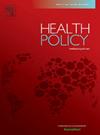注册政策对病人从属于家庭医生的影响:加拿大的准实验评估
IF 3.6
3区 医学
Q1 HEALTH CARE SCIENCES & SERVICES
引用次数: 0
摘要
隶属关系,定义为有一个通常的护理来源,通过患者和临床医生之间随着时间的推移反复互动的模式显示出来,可以影响患者的护理体验、护理的连续性和健康结果。许多司法管辖区实施初级保健注册政策,其动机是增加联系,从而改善下游患者的预后。然而,很少有证据表明这些政策对医患关系的影响。利用卫生管理数据,我们评估了加拿大魁北克省两项鼓励初级保健纳入的政策对人口水平的影响。我们使用准实验研究设计(差中差和中断时间序列)来估计可能归因于引入这些政策的隶属关系变化。2003年的政策针对的是老年人和/或慢性病患者,而2009年的政策针对的是普通人群。我们使用了三种衡量患者-医生关系的方法:二分类和连续的常规提供者连续性,以及报告常规医生(RRMD)指数。我们对这两项政策的分析在人口水平上的结果没有产生实质性的重要变化。我们对两种政策的效果估计在特定于每种方法的若干稳健性检查下是稳定的。我们的研究结果表明,鼓励注册的政策本身并不会对患者-医生关系产生影响。如果入组政策不足以增加患者与医生的关系,则需要进一步研究以了解影响关系和其他下游结果的因素。本文章由计算机程序翻译,如有差异,请以英文原文为准。
The effect of enrolment policies on patient affiliation to a family physician: A quasi-experimental evaluation in Canada
Affiliation, defined as having a usual source of care, revealed by patterns of repeated interactions between the patient and a clinician over time, can influence patients’ care experience, continuity of care and health outcomes. Many jurisdictions implement primary care enrolment policies, with the motivation to increase affiliation and thereby improve downstream patient outcomes. However, there is little evidence on the impacts of these policies on patient-physician affiliation.
Using health administrative data, we evaluated the population-level effects of two policies that encourage primary care enrolment on affiliation in Quebec, Canada. We used quasi-experimental study designs (difference-in-difference and interrupted-time-series) to estimate changes in affiliation that could be attributed to the introduction of these policies. The 2003 policy targeted the enrolment of elderly and/or chronically ill patients, whereas the 2009 policy targeted the general population. We used three measures of patient-physician affiliation: dichotomous and continuous usual provider continuity, and the Reporting a Regular Medical Doctor (RRMD) index.
Our analyses for both policies did not yield substantively important changes in our outcomes at the population level. Our effect estimates for both policies were stable under several robustness checks specific to each method. Our results suggest that policies that encourage enrolment do not, on their own, have an impact on patient-physician affiliation. If enrolment policies are not sufficient to increase patient-physician affiliation, further research is needed to understand the factors that influence both affiliation and other downstream outcomes.
求助全文
通过发布文献求助,成功后即可免费获取论文全文。
去求助
来源期刊

Health Policy
医学-卫生保健
CiteScore
6.40
自引率
6.10%
发文量
157
审稿时长
3-8 weeks
期刊介绍:
Health Policy is intended to be a vehicle for the exploration and discussion of health policy and health system issues and is aimed in particular at enhancing communication between health policy and system researchers, legislators, decision-makers and professionals concerned with developing, implementing, and analysing health policy, health systems and health care reforms, primarily in high-income countries outside the U.S.A.
 求助内容:
求助内容: 应助结果提醒方式:
应助结果提醒方式:


